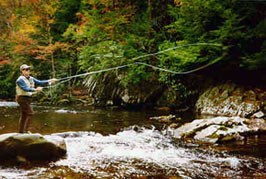
Sarah Spaulding, USGS Didymo (Didymosphenia geminata) or "rock snot" is an invasive single-celled algae species that smothers stream and riverbeds with mats of algae up to 8 inches thick. Historically, the range of Didymo was in the northern edges of North America, Europe and Asia, and considered very rare. Today, scientists have found that Didymo is able to adapt to new conditions, such as warmer water, resulting in Didymo being discovered in the streams of 16 states, including Tennessee. Learn more about the recent research concerning the presence and absence of Didymo in the region as well as treatment techniques being tested against the "rock snot". 
Steve Head Didymo cells cling to gear and equipment and can be transferred to new uncontaminated streams. These microscopic cells can remain alive for several days in a moist environment. Only one cell is needed to invade park streams. Once a Didymo cells contaminates a stream, it attaches itself firmly to the streambed and develops a stalk. The end of the stalk produces adhesive pads, which forms a thick mat that smothers the streambed.
To Prevent the Spread of Didymo: 1.Before coming to the park, clean all gear and equipment by: • REMOVING debris and strands of alga from your gear • CLEANING all gear in 2.5-5.0% solution of household bleach and hot water for 10 minutes. Hard to remove debris should be scrubbed with a biodegradable detergent. • DRYING all gear to touch, and then continue drying time for at least 48 more hours. 2.Use only clean, thoroughly dried gear and equipment 3.Report sightings of suspect algae to Great Smoky Mountains National Park staff For more information:
- Written by Jen Smith |
Last updated: January 7, 2020
